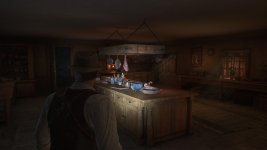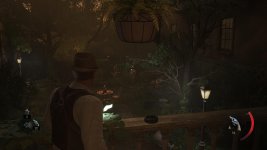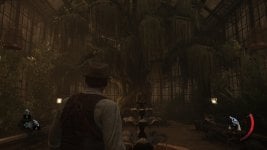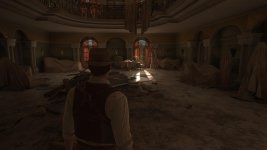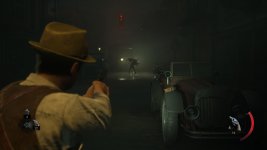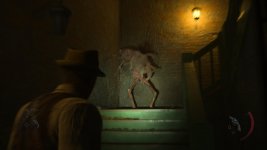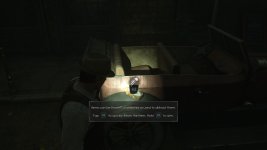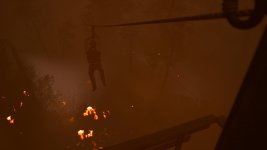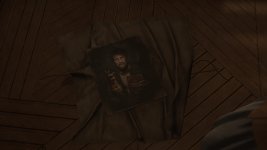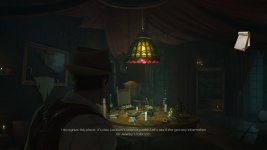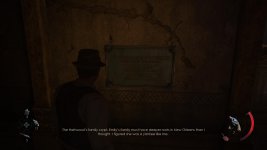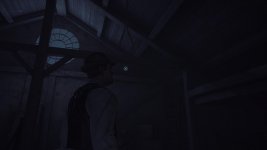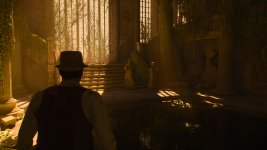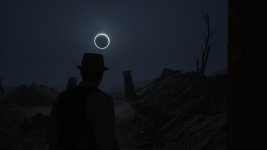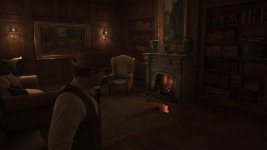 Alone in the Dark (2024) GBAtemp review
Alone in the Dark (2024) GBAtemp review
PlayStation 5
Product Information:
- Release Date (NA): March 20, 2024
- Release Date (EU): April 20, 2024
- Release Date (JP): April 20, 2024
- Publisher: THQ Nordic
- Developer: Pieces Interactive
- Genres: Survival Horror
- Also For: Computer, Xbox Series X|S
Game Features:
Review Approach:
Ph'nglui Mglw'nafh...
Private investigator Edward Carnby thought that he was in for an easy payday. His client, Emily Hartwood, requested that he accompanies her to Derceto Manor, a home for the mentally fatigued, where her uncle, Jeremy Hartwood, was currently being treated. She recently received a disturbing letter from her relative and felt it necessary to conduct a wellness check. The man suffered from paranoid delusions, a condition so common in the family that it earned the moniker of "The Hartwood Curse". The symptoms were all-too-familiar. Surreal visions of "The Dark Man" stalking his victims were shortly followed by suicidal ideation, so it was simply safer for Jeremy to be under professional supervision, or so Emily thought. Upon their arrival, the pair find out that the man is missing, so they immediately join the search. If only they knew that this was no ordinary disappearance, perhaps they would've never crossed the threshold of Derceto. Alas, they had no idea of the mansion's dark past and stepped into the darkness in blissful ignorance.
Alone in the Dark (2024) is another franchise reboot and it reimagines the events of the original game completely. While the game does feature many of the recurring characters, the plot is altogether different, so you can safely leave what you already know about the IP at the doorstep of Derceto. Knowing the events of the original enriches the experience for returning players, but will not help in solving the mystery and is not required for newcomers. You're put in the shoes of Edward Carnby (played by David Harbour) or Emily Hartwood (Jodie Comer) with a very simple task at hand - explore the depths of a 1920's Louisiana psychiatric hospital in search of her uncle whose suicide was the impetus behind the original AITD's plot. Before his disappearance Jeremy confessed that he believed events weren't unfolding "as they should have", which I felt was a nice nod to the fans of the series. The trail of breadcrumbs the man left behind leads you from one puzzle to the next, and as you interrogate Derceto's numerous inhabitants, you quickly learn that there's more to this story than meets the eye. Eventually your protagonist of choice comes across Jeremy's talisman and it becomes obvious that his "visions" are not only tangible, but also dangerous. The ancient artifact is imbued with voodoo magic and allows one to travel into what seems like Jeremy's memories, crossing the boundary between the real and the metaphysical. The investigation becomes two-pronged and the lines between reality and delusion are blurred. Jeremy's mental decline, slowly but surely, becomes your own. Uncovering the truth behind "The Hartwood Curse" will require you to explore not just the walls of the manor, but also Jeremy's mind, and the minds of the mentally deranged are anything but safe.
...Cthulhu R'lyeh...
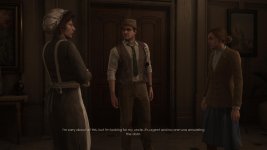
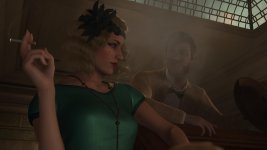


In this reimagining of the story Derceto is a mental institution and its inhabitants are appropriately cooky
In terms of gameplay you can expect the standard survival horror formula with a strong emphasis on puzzle-solving. Rather than reinvent the wheel, the game borrows gameplay elements of successful games in the genre and combines them into a more-or-less coherent vehicle to convey its story. You have your over-the-shoulder camera, you have your trusty flashlight, you have an arsenal of period-appropriate weaponry, you have your melee weapons with limited durability and you have the ability to throw various items scattered around the floor, from stones to molotov cocktails - nothing unusual, but you're not exactly left wanting either. As I played the game I that that "action" was not the main focus. Nothing makes that fact more obvious than the relative scarcity of the bestiary - most of the time you'll be facing vine creatures reminiscent of RE7's Molded and ghouls composed of a mish-mash of body parts, although there are some location-specific monsters to mix things up. This is not unusual for a game so heavily inspired by H.P. Lovecraft's fiction wherein actually fighting otherworldly horrors is not a good idea, but it's worth noting nonetheless.
Ultimately your most important weapons are your mind and your two legs as you'll spend most of the game following in Jeremy's footsteps back and forth the manor, collecting clues and solving puzzles, gradually accessing new areas and discovering secrets of both the past and the present. In fact, prepare to retread the same paths *a lot* as the game is designed to force you to revisit the same rooms with new-found knowledge or items quite often. By the time you reach the game's climax you'll explore locations ranging from the swamps of Louisiana to the Antarctic, with the manor house being more investigation-oriented and the visions more focused around combat. If you expected to be confined to the mansion then think again - thanks to the power of the amulet you get to visit places both real and imaginary, so long as you manage to solve the associated puzzles. The outcome of your adventure depends on how well you did in terms of collecting sets of artifacts called "Laganiappes", with three out of four endings being dependent on finding specific collectibles and performing the right actions as a given character. There's a lot here for gamers who love hunting for collectibles and getting lost in the lore, but the game is perfectly enjoyable even if you gloss over those secrets.
In terms of audio-visual presentation the game is a mixed bag. You will notice that all of my screenshots are taken using the game's Performance Mode on PlayStation 5, which is set as default. The reason for that is very simple - the game is absolutely unplayable in Quality Mode, with a framerate so unforgivingly low and frame skips so frequent that it is effectively impossible to enjoy, and to use it just for the sake of capturing nicer-looking footage would simply be dishonest. I fully understand that this is not a big budget AAA title by any stretch of the imagination, but that's no excuse for a lack of optimisation - perhaps if this level of graphical fidelity is not feasible on the platform then it shouldn't even be included in the settings menu. On the flip side, the sound direction is excellent. The ominous ambient sound really enhanced the overall atmosphere and the sound effects felt appropriately punchy. The star-studded cast delivered a decent show too, even if the lip syncing of the characters isn't the best. Overall, the game looks and sounds the part, so long as you're willing to put up with a bit of jankiness expected from a lower budget title here and there.
...Wgah'nagl Fhtagn!
AITD (2024) is a "different" kind of horror game, and having read some of the reviews floating around the web, I noticed a disparity between review scores and user scores that I thought was unfair. I actually chose to delay some of the other pieces I've been working on to give this game priority. How can it be that a title that averages 6's from reviewers can receive ratings closer to an 8 from actual users? Was this sunk cost fallacy, or were the reviewers missing something critical that fans actually appreciated? I needed to know, so I played all the way through both campaign and I think I "get it". If you're a person walking in and expecting tight, tense combat or resource management along the lines of Resident Evil, or a wealth of jump scares so common in the horror genre nowadays, you're bound to be disappointed. That's not the kind of experience Pieces Interactive was going for, it's not what Cthulhu-adjacent games are known for and it's not what you're getting here. The game's strength is its atmosphere, it's supposed to keep you on edge. The horror here is entirely psychological. The objective is not to scare you, or make you jump and scream, but to create tension and make you feel uncomfortable. AITD succeeds at that, and I can't help but wonder if many other reviewers picked up the title wanting it to be something it was never meant to be. Pieces Interactive were aiming at recreating and refreshing a 1992 classic, and the result is a game that lays a great foundation for the franchise's revival.
There's only one question that really matters in any review - did I have fun? Yes, absolutely. AITD is not a game for everyone, for all the reasons I've mentioned above and more. In many ways, it suffers from its own curse, the curse of nearly two decades of expectations built-up while the industry at large moved on to more action-oriented pastures full of sudden loud noises and thrills. With an average playtime of 7-8 hours per playthrough, and a bare minimum of two runs to discover all of its secrets, it's not the longest game in the world either, but then again, I'm a player who prefers a shorter playtime if the alternative is stretching the game thin and wasting my time. Is it worth it? That depends. If you're a player who's willing to keep an open mind, AITD feels like an atmospheric throwback with a gripping narrative and an excellent twist ending that justifies any jankiness you may have experienced along the way. If you're less forgiving perhaps it's one of the titles worth picking up on a sale. Whichever of the two you may be, AITD is by far the best entry in the series since the days of the original PlayStation, and I sincerely hope to see more from Pieces Interactive in the future. The game they delivered is an unpolished gem, but if you tilt it just right, you'll see the shine hidden underneath its rough exterior.
Verdict
- Great sound design that creates a tense atmosphere
- An interesting reimagining of the original AITD story
- Fantastic twist ending that ties a nice bow on the mystery, leaving the door open for a sequel
- A throwback to old school survival horror that's more puzzle and story-heavy
- Despite offering two different characters their playthroughts are nearly identical outside of one (admittedly impactful and personal) end game sequence
- The Quality graphics mode is effectively unplayable
- Monsters lack variety
- Somewhat janky combat
- Poor lip syncing
